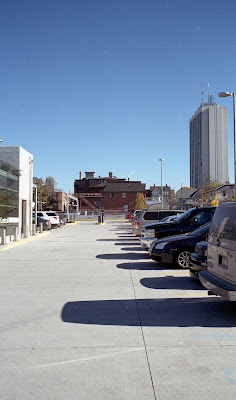I don't know about others, but even though I have been developing my own b&w film for many, many years, I hesitated about trying to develop C-41 or E-6 films at home. Like so many things, it's the fear of the unknown and of course, fear of screwing it up. So many steps, and the temperatures... how can I even try this? I suppose someone that has never developed b&w film might feel the same way before doing so, and consequently realizing it was actually fairly easy.
So, with some urging by my super pals, Leslie and Mike, I ordered a couple of Unicolor C-41 kits from the
FPP store. For $19 a kit, it's a pretty cheap experiment, and it's only a 3-step process. The fun fact here is that the kits are manufactured in Dexter Michigan, by Photo Systems, Inc. I have driven past the place many times over the years without giving it a thought!
 |
| 1-L C-41 kit from FPP |
I opened the first kit and carefully read the directions. All the chems are dry and need to be mixed to 1L final amounts. I highly recommend doing this mixing AND the developing with proper PPO - gloves, lab coat or apron, and eye protection. It's not that the stuff is dangerous, but you are mixing chemicals, after all. Make sure that you have 3 clean plastic 1L bottles for the Developer, Blix, and Stabilizer solutions. I suggest the brown plastic darkroom containers. Make sure each one is labeled properly as to the contents. You can even put a (1) for the Developer, a (2) for the Blix and a (3) for the Stabilizer, in case you are worried about not doing things in the right sequence. The Blix is a combination bleach and fix, and is probably the most caustic of the things you will deal with.
Temperature -- I use a deep plastic tub with hot water in it to bring the final temps of the Developer and Blix to 102°F. The pre-soak (1 minute) should also be around the same temp. Having several dial-type thermometers is very useful for monitoring the temps. When doing the developing, make sure you immerse the tank into the tub to maintain the developer temp. After finishing the Blix step, wash the film in water that is between 95°F and 105°F. The Stabilizer is room temp., and is the very last step. From Leslie, I got the tip to use a microfiber cloth wetted with Stabilizer to wipe down the back of the film (NOT the emulsion side) to avoid spotting (added in edit -- THIS IS AFTER removing the film from the Stabilizer bath. I found I was getting spots on the film side upon drying).
After each step, pour the Developer, Blix and Stabilizer back into their respective containers for re-use. This is not a 1-shot process. Each liter should be good for at least 10 rolls of film.
You will need to "burp" the Blix after each set of inversions, as it generates some gas during its part of the process. I use Jobo tanks and reels, so the top plastic seal just needs to be loose after the inversion set.
My initial fears were quite unfounded, as my film came out very good. My first roll was some long-expired Kodak HD 400, and the results were what one might expect from old film. My second and third rolls were fresh Kodak 200, and the results were excellent. So, I am now doing my owwn color developing. E-6 is next, and the temperatures are not as high as C-41.
Some examples from my rolls (all scanned on Epson V700) :
 |
| Plattsburgh, NY - Kodak 200, Olympus Trip |
 |
| Amenia, NY, expired Kodak HD400, Olympus Trip |
 |
| Kodak, 200, Olympus Trip |
 |
| Adirondacks, Kodak 200, Olympus Trip |
 |
| Ann Arbor, Kodak 200, Leica M2 |
 |
| Ann Arbor, Leica M2, Kodak 200 |





















